Employee Relations in Singapore: Challenges and Opportunities
VerifiedAdded on 2023/06/03
|7
|2348
|369
Report
AI Summary
This report provides a comprehensive analysis of employee relations in Singapore, examining the evolving landscape of employer-employee dynamics. It delves into the impact of globalization, intense competition, and technological advancements on workplace practices. The report highlights key issues such as the balance of power between employers and employees, the role of labor unions, and the influence of government policies and regulations on employment relationships. It explores challenges related to an aging workforce, the integration of technology, and the need for innovative HR practices to foster employee motivation and commitment. The report also discusses the importance of adapting to societal changes and the need for open communication and conflict resolution mechanisms to maintain a harmonious and productive work environment. Furthermore, it emphasizes the importance of strategic human resource management to address the challenges and leverage opportunities in Singapore's business landscape, offering insights into how organizations can navigate the complexities of employee relations to achieve sustainable success.
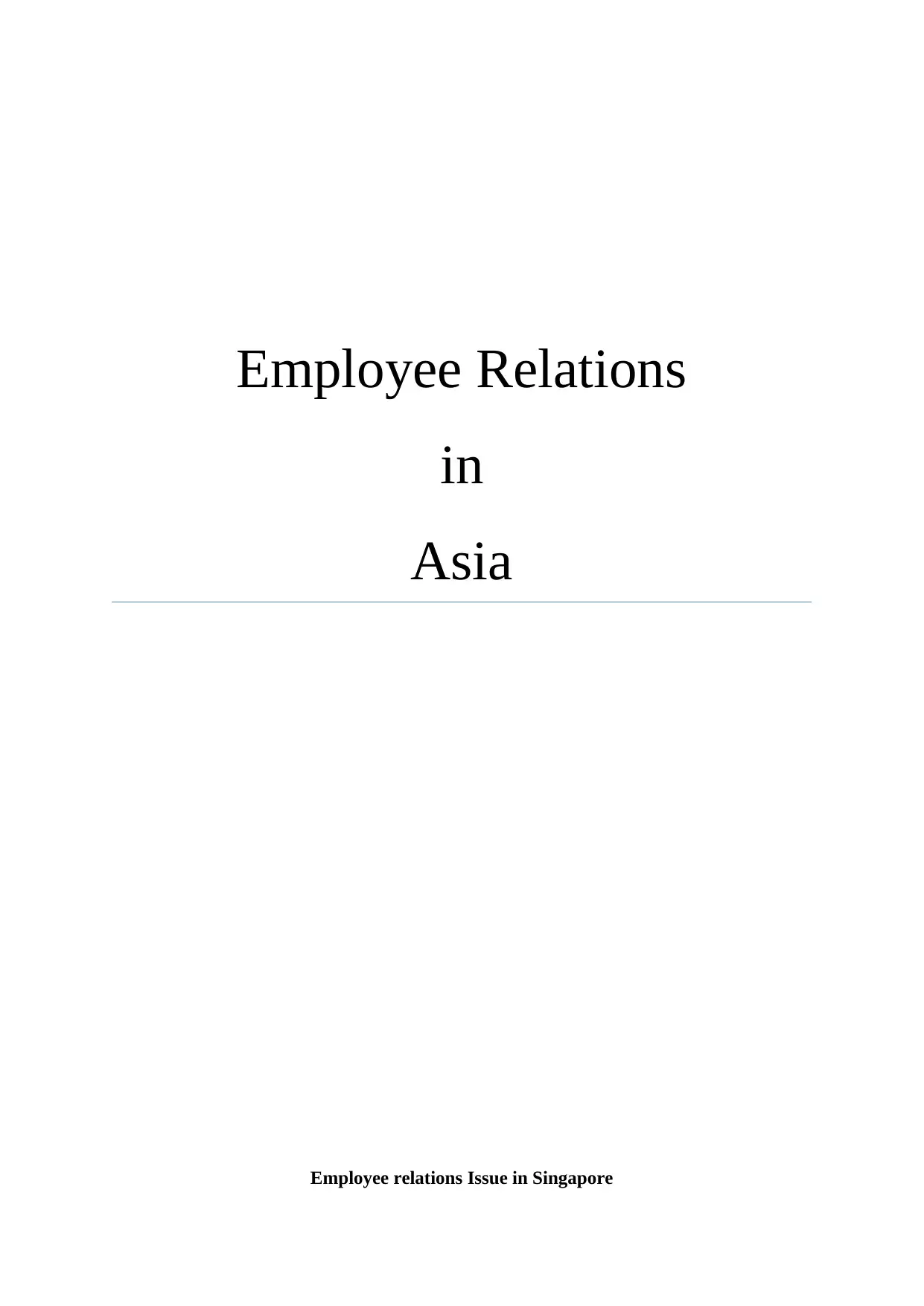
Employee Relations
in
Asia
Employee relations Issue in Singapore
in
Asia
Employee relations Issue in Singapore
Paraphrase This Document
Need a fresh take? Get an instant paraphrase of this document with our AI Paraphraser
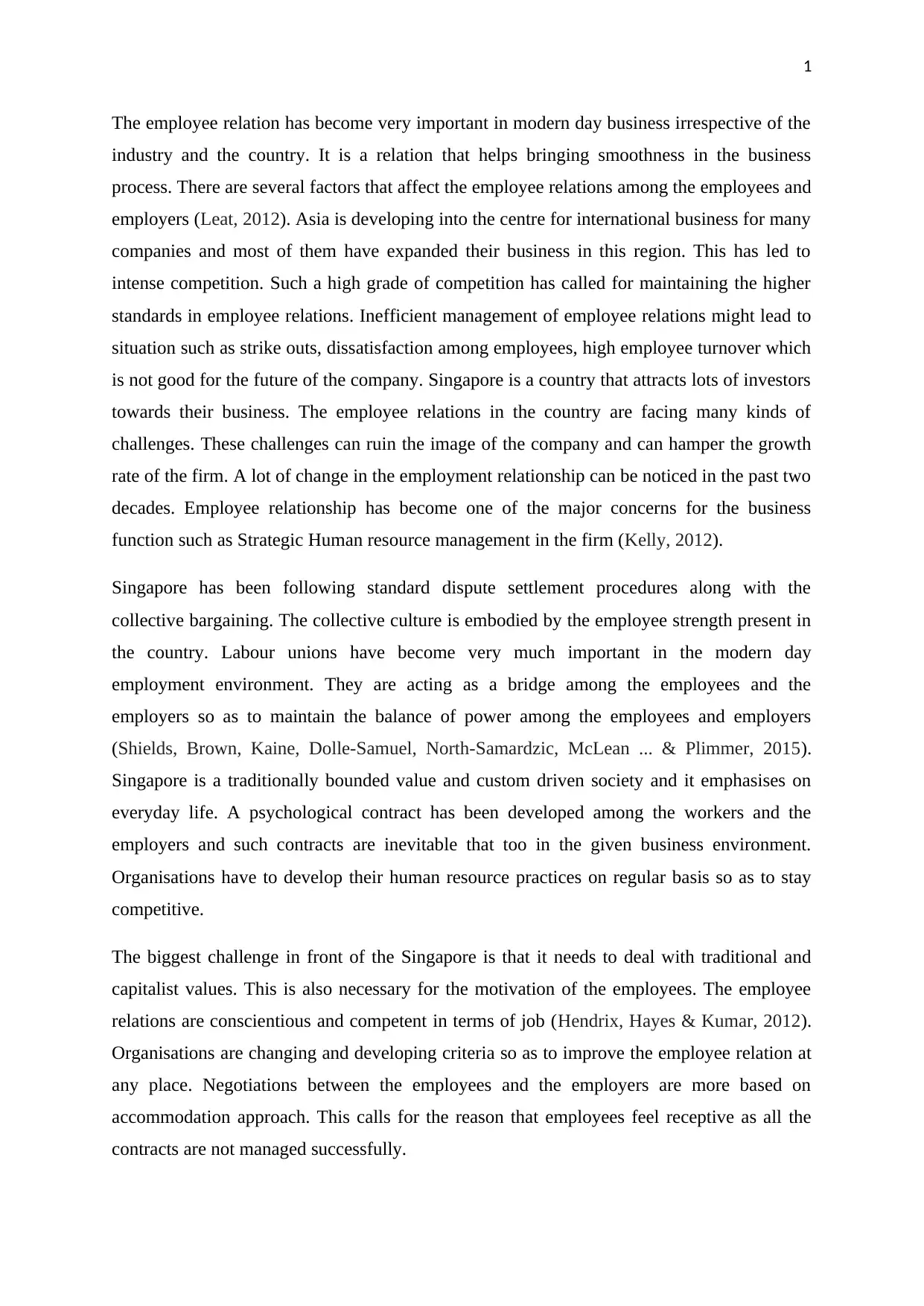
1
The employee relation has become very important in modern day business irrespective of the
industry and the country. It is a relation that helps bringing smoothness in the business
process. There are several factors that affect the employee relations among the employees and
employers (Leat, 2012). Asia is developing into the centre for international business for many
companies and most of them have expanded their business in this region. This has led to
intense competition. Such a high grade of competition has called for maintaining the higher
standards in employee relations. Inefficient management of employee relations might lead to
situation such as strike outs, dissatisfaction among employees, high employee turnover which
is not good for the future of the company. Singapore is a country that attracts lots of investors
towards their business. The employee relations in the country are facing many kinds of
challenges. These challenges can ruin the image of the company and can hamper the growth
rate of the firm. A lot of change in the employment relationship can be noticed in the past two
decades. Employee relationship has become one of the major concerns for the business
function such as Strategic Human resource management in the firm (Kelly, 2012).
Singapore has been following standard dispute settlement procedures along with the
collective bargaining. The collective culture is embodied by the employee strength present in
the country. Labour unions have become very much important in the modern day
employment environment. They are acting as a bridge among the employees and the
employers so as to maintain the balance of power among the employees and employers
(Shields, Brown, Kaine, Dolle-Samuel, North-Samardzic, McLean ... & Plimmer, 2015).
Singapore is a traditionally bounded value and custom driven society and it emphasises on
everyday life. A psychological contract has been developed among the workers and the
employers and such contracts are inevitable that too in the given business environment.
Organisations have to develop their human resource practices on regular basis so as to stay
competitive.
The biggest challenge in front of the Singapore is that it needs to deal with traditional and
capitalist values. This is also necessary for the motivation of the employees. The employee
relations are conscientious and competent in terms of job (Hendrix, Hayes & Kumar, 2012).
Organisations are changing and developing criteria so as to improve the employee relation at
any place. Negotiations between the employees and the employers are more based on
accommodation approach. This calls for the reason that employees feel receptive as all the
contracts are not managed successfully.
The employee relation has become very important in modern day business irrespective of the
industry and the country. It is a relation that helps bringing smoothness in the business
process. There are several factors that affect the employee relations among the employees and
employers (Leat, 2012). Asia is developing into the centre for international business for many
companies and most of them have expanded their business in this region. This has led to
intense competition. Such a high grade of competition has called for maintaining the higher
standards in employee relations. Inefficient management of employee relations might lead to
situation such as strike outs, dissatisfaction among employees, high employee turnover which
is not good for the future of the company. Singapore is a country that attracts lots of investors
towards their business. The employee relations in the country are facing many kinds of
challenges. These challenges can ruin the image of the company and can hamper the growth
rate of the firm. A lot of change in the employment relationship can be noticed in the past two
decades. Employee relationship has become one of the major concerns for the business
function such as Strategic Human resource management in the firm (Kelly, 2012).
Singapore has been following standard dispute settlement procedures along with the
collective bargaining. The collective culture is embodied by the employee strength present in
the country. Labour unions have become very much important in the modern day
employment environment. They are acting as a bridge among the employees and the
employers so as to maintain the balance of power among the employees and employers
(Shields, Brown, Kaine, Dolle-Samuel, North-Samardzic, McLean ... & Plimmer, 2015).
Singapore is a traditionally bounded value and custom driven society and it emphasises on
everyday life. A psychological contract has been developed among the workers and the
employers and such contracts are inevitable that too in the given business environment.
Organisations have to develop their human resource practices on regular basis so as to stay
competitive.
The biggest challenge in front of the Singapore is that it needs to deal with traditional and
capitalist values. This is also necessary for the motivation of the employees. The employee
relations are conscientious and competent in terms of job (Hendrix, Hayes & Kumar, 2012).
Organisations are changing and developing criteria so as to improve the employee relation at
any place. Negotiations between the employees and the employers are more based on
accommodation approach. This calls for the reason that employees feel receptive as all the
contracts are not managed successfully.
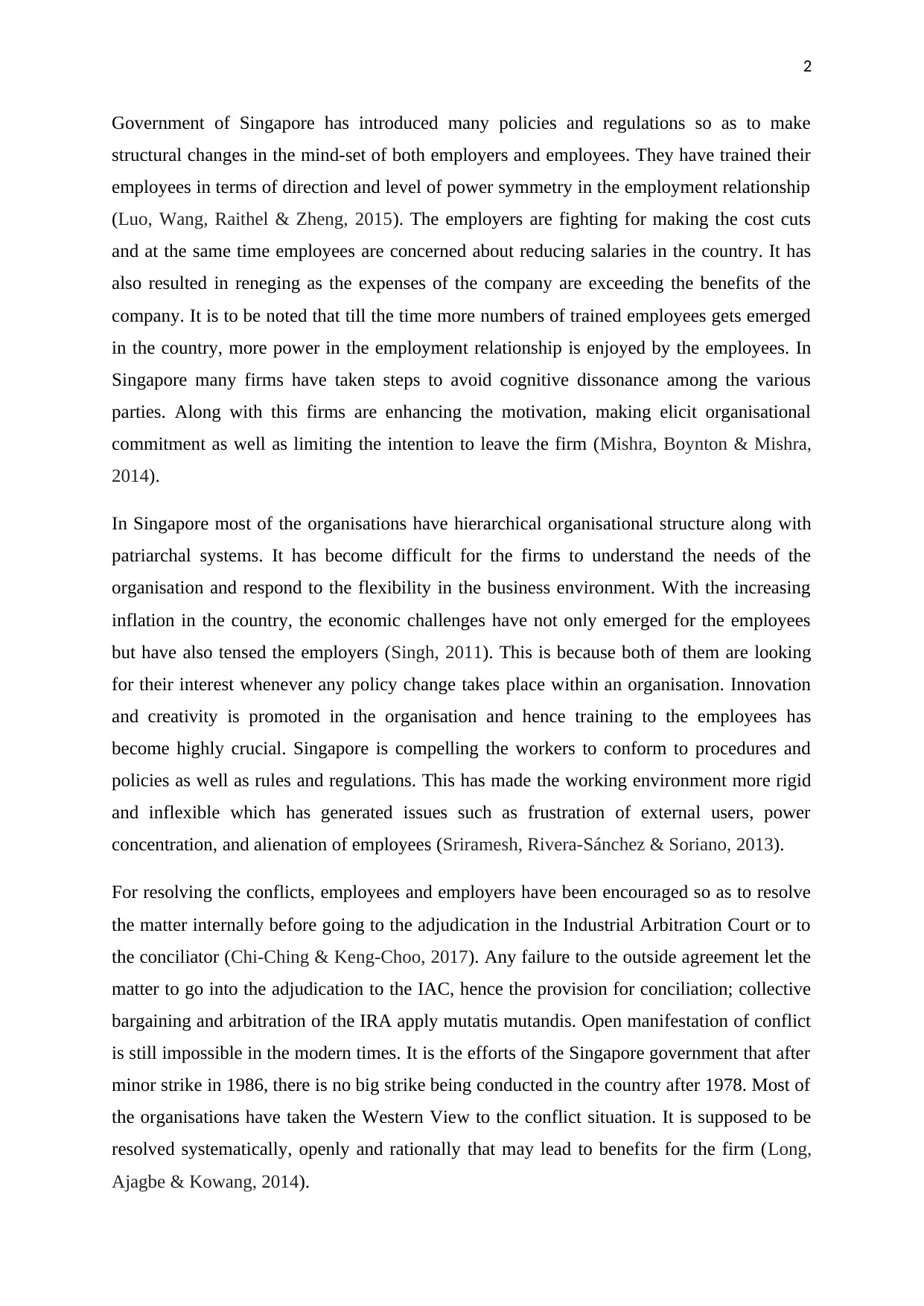
2
Government of Singapore has introduced many policies and regulations so as to make
structural changes in the mind-set of both employers and employees. They have trained their
employees in terms of direction and level of power symmetry in the employment relationship
(Luo, Wang, Raithel & Zheng, 2015). The employers are fighting for making the cost cuts
and at the same time employees are concerned about reducing salaries in the country. It has
also resulted in reneging as the expenses of the company are exceeding the benefits of the
company. It is to be noted that till the time more numbers of trained employees gets emerged
in the country, more power in the employment relationship is enjoyed by the employees. In
Singapore many firms have taken steps to avoid cognitive dissonance among the various
parties. Along with this firms are enhancing the motivation, making elicit organisational
commitment as well as limiting the intention to leave the firm (Mishra, Boynton & Mishra,
2014).
In Singapore most of the organisations have hierarchical organisational structure along with
patriarchal systems. It has become difficult for the firms to understand the needs of the
organisation and respond to the flexibility in the business environment. With the increasing
inflation in the country, the economic challenges have not only emerged for the employees
but have also tensed the employers (Singh, 2011). This is because both of them are looking
for their interest whenever any policy change takes place within an organisation. Innovation
and creativity is promoted in the organisation and hence training to the employees has
become highly crucial. Singapore is compelling the workers to conform to procedures and
policies as well as rules and regulations. This has made the working environment more rigid
and inflexible which has generated issues such as frustration of external users, power
concentration, and alienation of employees (Sriramesh, Rivera-Sánchez & Soriano, 2013).
For resolving the conflicts, employees and employers have been encouraged so as to resolve
the matter internally before going to the adjudication in the Industrial Arbitration Court or to
the conciliator (Chi-Ching & Keng-Choo, 2017). Any failure to the outside agreement let the
matter to go into the adjudication to the IAC, hence the provision for conciliation; collective
bargaining and arbitration of the IRA apply mutatis mutandis. Open manifestation of conflict
is still impossible in the modern times. It is the efforts of the Singapore government that after
minor strike in 1986, there is no big strike being conducted in the country after 1978. Most of
the organisations have taken the Western View to the conflict situation. It is supposed to be
resolved systematically, openly and rationally that may lead to benefits for the firm (Long,
Ajagbe & Kowang, 2014).
Government of Singapore has introduced many policies and regulations so as to make
structural changes in the mind-set of both employers and employees. They have trained their
employees in terms of direction and level of power symmetry in the employment relationship
(Luo, Wang, Raithel & Zheng, 2015). The employers are fighting for making the cost cuts
and at the same time employees are concerned about reducing salaries in the country. It has
also resulted in reneging as the expenses of the company are exceeding the benefits of the
company. It is to be noted that till the time more numbers of trained employees gets emerged
in the country, more power in the employment relationship is enjoyed by the employees. In
Singapore many firms have taken steps to avoid cognitive dissonance among the various
parties. Along with this firms are enhancing the motivation, making elicit organisational
commitment as well as limiting the intention to leave the firm (Mishra, Boynton & Mishra,
2014).
In Singapore most of the organisations have hierarchical organisational structure along with
patriarchal systems. It has become difficult for the firms to understand the needs of the
organisation and respond to the flexibility in the business environment. With the increasing
inflation in the country, the economic challenges have not only emerged for the employees
but have also tensed the employers (Singh, 2011). This is because both of them are looking
for their interest whenever any policy change takes place within an organisation. Innovation
and creativity is promoted in the organisation and hence training to the employees has
become highly crucial. Singapore is compelling the workers to conform to procedures and
policies as well as rules and regulations. This has made the working environment more rigid
and inflexible which has generated issues such as frustration of external users, power
concentration, and alienation of employees (Sriramesh, Rivera-Sánchez & Soriano, 2013).
For resolving the conflicts, employees and employers have been encouraged so as to resolve
the matter internally before going to the adjudication in the Industrial Arbitration Court or to
the conciliator (Chi-Ching & Keng-Choo, 2017). Any failure to the outside agreement let the
matter to go into the adjudication to the IAC, hence the provision for conciliation; collective
bargaining and arbitration of the IRA apply mutatis mutandis. Open manifestation of conflict
is still impossible in the modern times. It is the efforts of the Singapore government that after
minor strike in 1986, there is no big strike being conducted in the country after 1978. Most of
the organisations have taken the Western View to the conflict situation. It is supposed to be
resolved systematically, openly and rationally that may lead to benefits for the firm (Long,
Ajagbe & Kowang, 2014).
⊘ This is a preview!⊘
Do you want full access?
Subscribe today to unlock all pages.

Trusted by 1+ million students worldwide
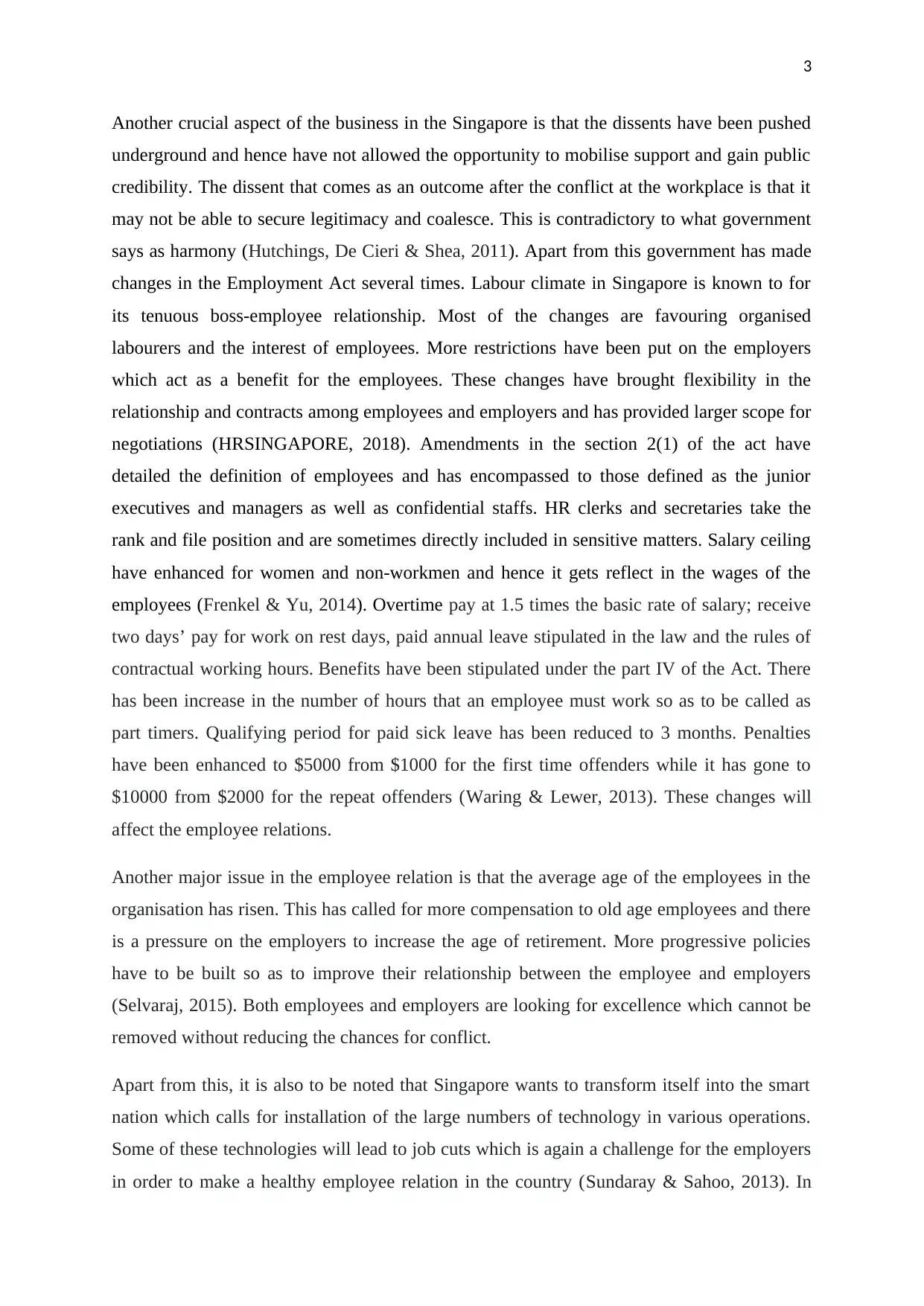
3
Another crucial aspect of the business in the Singapore is that the dissents have been pushed
underground and hence have not allowed the opportunity to mobilise support and gain public
credibility. The dissent that comes as an outcome after the conflict at the workplace is that it
may not be able to secure legitimacy and coalesce. This is contradictory to what government
says as harmony (Hutchings, De Cieri & Shea, 2011). Apart from this government has made
changes in the Employment Act several times. Labour climate in Singapore is known to for
its tenuous boss-employee relationship. Most of the changes are favouring organised
labourers and the interest of employees. More restrictions have been put on the employers
which act as a benefit for the employees. These changes have brought flexibility in the
relationship and contracts among employees and employers and has provided larger scope for
negotiations (HRSINGAPORE, 2018). Amendments in the section 2(1) of the act have
detailed the definition of employees and has encompassed to those defined as the junior
executives and managers as well as confidential staffs. HR clerks and secretaries take the
rank and file position and are sometimes directly included in sensitive matters. Salary ceiling
have enhanced for women and non-workmen and hence it gets reflect in the wages of the
employees (Frenkel & Yu, 2014). Overtime pay at 1.5 times the basic rate of salary; receive
two days’ pay for work on rest days, paid annual leave stipulated in the law and the rules of
contractual working hours. Benefits have been stipulated under the part IV of the Act. There
has been increase in the number of hours that an employee must work so as to be called as
part timers. Qualifying period for paid sick leave has been reduced to 3 months. Penalties
have been enhanced to $5000 from $1000 for the first time offenders while it has gone to
$10000 from $2000 for the repeat offenders (Waring & Lewer, 2013). These changes will
affect the employee relations.
Another major issue in the employee relation is that the average age of the employees in the
organisation has risen. This has called for more compensation to old age employees and there
is a pressure on the employers to increase the age of retirement. More progressive policies
have to be built so as to improve their relationship between the employee and employers
(Selvaraj, 2015). Both employees and employers are looking for excellence which cannot be
removed without reducing the chances for conflict.
Apart from this, it is also to be noted that Singapore wants to transform itself into the smart
nation which calls for installation of the large numbers of technology in various operations.
Some of these technologies will lead to job cuts which is again a challenge for the employers
in order to make a healthy employee relation in the country (Sundaray & Sahoo, 2013). In
Another crucial aspect of the business in the Singapore is that the dissents have been pushed
underground and hence have not allowed the opportunity to mobilise support and gain public
credibility. The dissent that comes as an outcome after the conflict at the workplace is that it
may not be able to secure legitimacy and coalesce. This is contradictory to what government
says as harmony (Hutchings, De Cieri & Shea, 2011). Apart from this government has made
changes in the Employment Act several times. Labour climate in Singapore is known to for
its tenuous boss-employee relationship. Most of the changes are favouring organised
labourers and the interest of employees. More restrictions have been put on the employers
which act as a benefit for the employees. These changes have brought flexibility in the
relationship and contracts among employees and employers and has provided larger scope for
negotiations (HRSINGAPORE, 2018). Amendments in the section 2(1) of the act have
detailed the definition of employees and has encompassed to those defined as the junior
executives and managers as well as confidential staffs. HR clerks and secretaries take the
rank and file position and are sometimes directly included in sensitive matters. Salary ceiling
have enhanced for women and non-workmen and hence it gets reflect in the wages of the
employees (Frenkel & Yu, 2014). Overtime pay at 1.5 times the basic rate of salary; receive
two days’ pay for work on rest days, paid annual leave stipulated in the law and the rules of
contractual working hours. Benefits have been stipulated under the part IV of the Act. There
has been increase in the number of hours that an employee must work so as to be called as
part timers. Qualifying period for paid sick leave has been reduced to 3 months. Penalties
have been enhanced to $5000 from $1000 for the first time offenders while it has gone to
$10000 from $2000 for the repeat offenders (Waring & Lewer, 2013). These changes will
affect the employee relations.
Another major issue in the employee relation is that the average age of the employees in the
organisation has risen. This has called for more compensation to old age employees and there
is a pressure on the employers to increase the age of retirement. More progressive policies
have to be built so as to improve their relationship between the employee and employers
(Selvaraj, 2015). Both employees and employers are looking for excellence which cannot be
removed without reducing the chances for conflict.
Apart from this, it is also to be noted that Singapore wants to transform itself into the smart
nation which calls for installation of the large numbers of technology in various operations.
Some of these technologies will lead to job cuts which is again a challenge for the employers
in order to make a healthy employee relation in the country (Sundaray & Sahoo, 2013). In
Paraphrase This Document
Need a fresh take? Get an instant paraphrase of this document with our AI Paraphraser
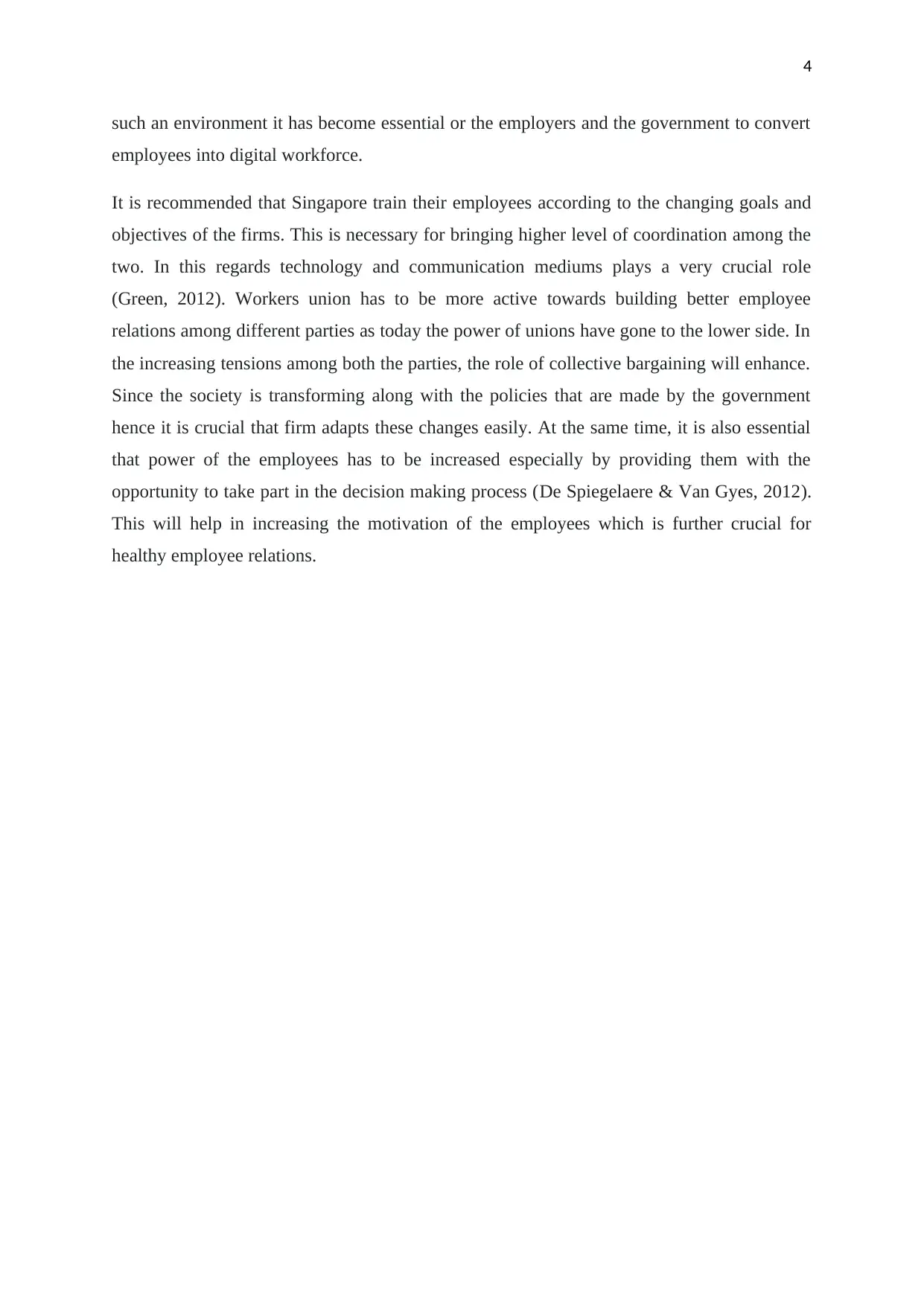
4
such an environment it has become essential or the employers and the government to convert
employees into digital workforce.
It is recommended that Singapore train their employees according to the changing goals and
objectives of the firms. This is necessary for bringing higher level of coordination among the
two. In this regards technology and communication mediums plays a very crucial role
(Green, 2012). Workers union has to be more active towards building better employee
relations among different parties as today the power of unions have gone to the lower side. In
the increasing tensions among both the parties, the role of collective bargaining will enhance.
Since the society is transforming along with the policies that are made by the government
hence it is crucial that firm adapts these changes easily. At the same time, it is also essential
that power of the employees has to be increased especially by providing them with the
opportunity to take part in the decision making process (De Spiegelaere & Van Gyes, 2012).
This will help in increasing the motivation of the employees which is further crucial for
healthy employee relations.
such an environment it has become essential or the employers and the government to convert
employees into digital workforce.
It is recommended that Singapore train their employees according to the changing goals and
objectives of the firms. This is necessary for bringing higher level of coordination among the
two. In this regards technology and communication mediums plays a very crucial role
(Green, 2012). Workers union has to be more active towards building better employee
relations among different parties as today the power of unions have gone to the lower side. In
the increasing tensions among both the parties, the role of collective bargaining will enhance.
Since the society is transforming along with the policies that are made by the government
hence it is crucial that firm adapts these changes easily. At the same time, it is also essential
that power of the employees has to be increased especially by providing them with the
opportunity to take part in the decision making process (De Spiegelaere & Van Gyes, 2012).
This will help in increasing the motivation of the employees which is further crucial for
healthy employee relations.
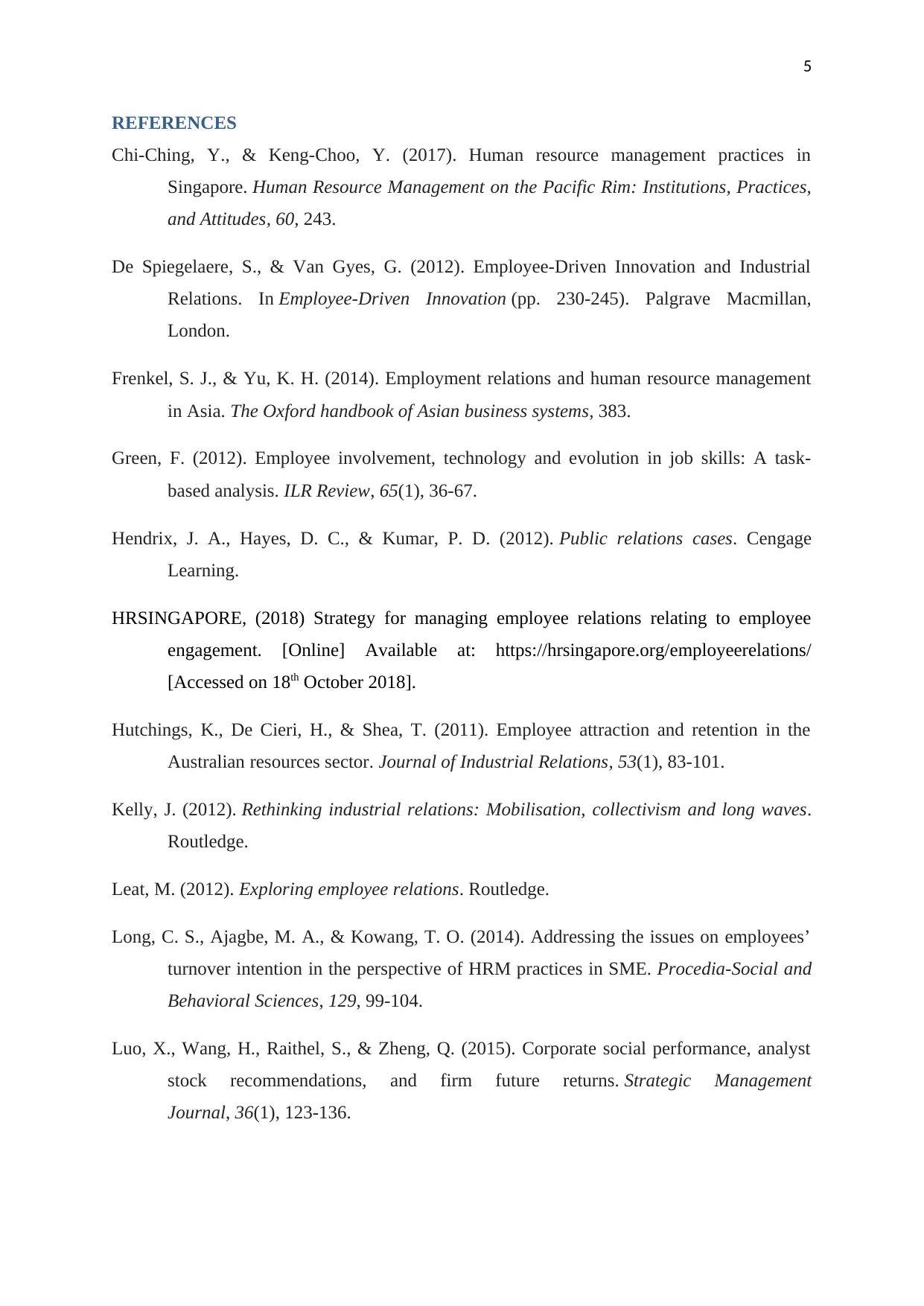
5
REFERENCES
Chi-Ching, Y., & Keng-Choo, Y. (2017). Human resource management practices in
Singapore. Human Resource Management on the Pacific Rim: Institutions, Practices,
and Attitudes, 60, 243.
De Spiegelaere, S., & Van Gyes, G. (2012). Employee-Driven Innovation and Industrial
Relations. In Employee-Driven Innovation (pp. 230-245). Palgrave Macmillan,
London.
Frenkel, S. J., & Yu, K. H. (2014). Employment relations and human resource management
in Asia. The Oxford handbook of Asian business systems, 383.
Green, F. (2012). Employee involvement, technology and evolution in job skills: A task-
based analysis. ILR Review, 65(1), 36-67.
Hendrix, J. A., Hayes, D. C., & Kumar, P. D. (2012). Public relations cases. Cengage
Learning.
HRSINGAPORE, (2018) Strategy for managing employee relations relating to employee
engagement. [Online] Available at: https://hrsingapore.org/employeerelations/
[Accessed on 18th October 2018].
Hutchings, K., De Cieri, H., & Shea, T. (2011). Employee attraction and retention in the
Australian resources sector. Journal of Industrial Relations, 53(1), 83-101.
Kelly, J. (2012). Rethinking industrial relations: Mobilisation, collectivism and long waves.
Routledge.
Leat, M. (2012). Exploring employee relations. Routledge.
Long, C. S., Ajagbe, M. A., & Kowang, T. O. (2014). Addressing the issues on employees’
turnover intention in the perspective of HRM practices in SME. Procedia-Social and
Behavioral Sciences, 129, 99-104.
Luo, X., Wang, H., Raithel, S., & Zheng, Q. (2015). Corporate social performance, analyst
stock recommendations, and firm future returns. Strategic Management
Journal, 36(1), 123-136.
REFERENCES
Chi-Ching, Y., & Keng-Choo, Y. (2017). Human resource management practices in
Singapore. Human Resource Management on the Pacific Rim: Institutions, Practices,
and Attitudes, 60, 243.
De Spiegelaere, S., & Van Gyes, G. (2012). Employee-Driven Innovation and Industrial
Relations. In Employee-Driven Innovation (pp. 230-245). Palgrave Macmillan,
London.
Frenkel, S. J., & Yu, K. H. (2014). Employment relations and human resource management
in Asia. The Oxford handbook of Asian business systems, 383.
Green, F. (2012). Employee involvement, technology and evolution in job skills: A task-
based analysis. ILR Review, 65(1), 36-67.
Hendrix, J. A., Hayes, D. C., & Kumar, P. D. (2012). Public relations cases. Cengage
Learning.
HRSINGAPORE, (2018) Strategy for managing employee relations relating to employee
engagement. [Online] Available at: https://hrsingapore.org/employeerelations/
[Accessed on 18th October 2018].
Hutchings, K., De Cieri, H., & Shea, T. (2011). Employee attraction and retention in the
Australian resources sector. Journal of Industrial Relations, 53(1), 83-101.
Kelly, J. (2012). Rethinking industrial relations: Mobilisation, collectivism and long waves.
Routledge.
Leat, M. (2012). Exploring employee relations. Routledge.
Long, C. S., Ajagbe, M. A., & Kowang, T. O. (2014). Addressing the issues on employees’
turnover intention in the perspective of HRM practices in SME. Procedia-Social and
Behavioral Sciences, 129, 99-104.
Luo, X., Wang, H., Raithel, S., & Zheng, Q. (2015). Corporate social performance, analyst
stock recommendations, and firm future returns. Strategic Management
Journal, 36(1), 123-136.
⊘ This is a preview!⊘
Do you want full access?
Subscribe today to unlock all pages.

Trusted by 1+ million students worldwide
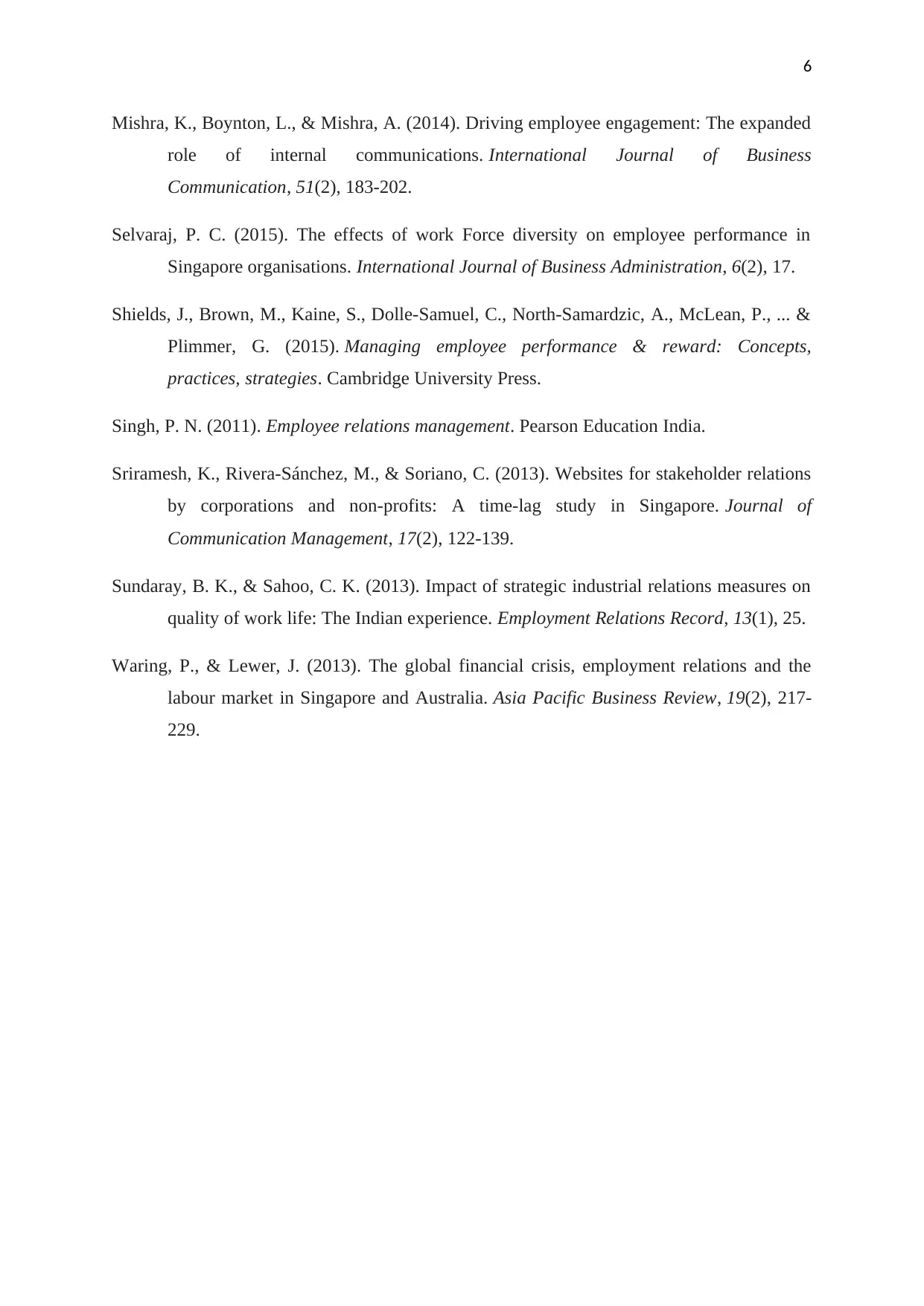
6
Mishra, K., Boynton, L., & Mishra, A. (2014). Driving employee engagement: The expanded
role of internal communications. International Journal of Business
Communication, 51(2), 183-202.
Selvaraj, P. C. (2015). The effects of work Force diversity on employee performance in
Singapore organisations. International Journal of Business Administration, 6(2), 17.
Shields, J., Brown, M., Kaine, S., Dolle-Samuel, C., North-Samardzic, A., McLean, P., ... &
Plimmer, G. (2015). Managing employee performance & reward: Concepts,
practices, strategies. Cambridge University Press.
Singh, P. N. (2011). Employee relations management. Pearson Education India.
Sriramesh, K., Rivera-Sánchez, M., & Soriano, C. (2013). Websites for stakeholder relations
by corporations and non-profits: A time-lag study in Singapore. Journal of
Communication Management, 17(2), 122-139.
Sundaray, B. K., & Sahoo, C. K. (2013). Impact of strategic industrial relations measures on
quality of work life: The Indian experience. Employment Relations Record, 13(1), 25.
Waring, P., & Lewer, J. (2013). The global financial crisis, employment relations and the
labour market in Singapore and Australia. Asia Pacific Business Review, 19(2), 217-
229.
Mishra, K., Boynton, L., & Mishra, A. (2014). Driving employee engagement: The expanded
role of internal communications. International Journal of Business
Communication, 51(2), 183-202.
Selvaraj, P. C. (2015). The effects of work Force diversity on employee performance in
Singapore organisations. International Journal of Business Administration, 6(2), 17.
Shields, J., Brown, M., Kaine, S., Dolle-Samuel, C., North-Samardzic, A., McLean, P., ... &
Plimmer, G. (2015). Managing employee performance & reward: Concepts,
practices, strategies. Cambridge University Press.
Singh, P. N. (2011). Employee relations management. Pearson Education India.
Sriramesh, K., Rivera-Sánchez, M., & Soriano, C. (2013). Websites for stakeholder relations
by corporations and non-profits: A time-lag study in Singapore. Journal of
Communication Management, 17(2), 122-139.
Sundaray, B. K., & Sahoo, C. K. (2013). Impact of strategic industrial relations measures on
quality of work life: The Indian experience. Employment Relations Record, 13(1), 25.
Waring, P., & Lewer, J. (2013). The global financial crisis, employment relations and the
labour market in Singapore and Australia. Asia Pacific Business Review, 19(2), 217-
229.
1 out of 7
Related Documents
Your All-in-One AI-Powered Toolkit for Academic Success.
+13062052269
info@desklib.com
Available 24*7 on WhatsApp / Email
![[object Object]](/_next/static/media/star-bottom.7253800d.svg)
Unlock your academic potential
Copyright © 2020–2025 A2Z Services. All Rights Reserved. Developed and managed by ZUCOL.





